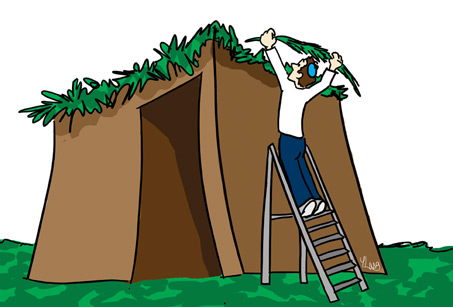
Order of the Shaking of the Lulab. Here
Click here to send a multimedia e-greeting card
On the fifteenth day of this seventh month, five days after Yom Kippur comes the Festival of Sukkoth, during which we are commanded to dwell in booths (Sukkoth) and to take the Four Species (including the Lulab and Ethrogh).
By sitting in the Sukkah we commemorate the fact that our forefathers sat in Sukkoth, as it is written: “Kee Bassukkoth Hoshabti Eth Bene Yisrael” (because I made the Children of Israel dwell in booths). There is a difference of opinion as to whether these were real booths, or whether this refers to the Clouds of Glory that surrounded Bene Yisrael, on all four sides, above and below.
Qiddush on the first night (and second too, for those who live outside the Land of Israel) requires Layla Wadday, – i.e. it must be made after the stars come out.
It is made in the Sukkah and – on the first night – includes the Berakha (blessing) of Leesheb Bassukkah followed by Sheheheyanu. On the second night, the Berakha of Leesheb Bassukkah is recited last.
The Berakha of Leesheb Bassukkah is recited standing during the Qiddush at night and one only sits after its completion. During the day, however, it is recited while seated.
According to the Sepharadim, this Berakha should only be pronounced if one has the intention of eating bread, however, if one simply wishes to eat a piece of cake or something similar, it should not be recited.
A special chair should be placed in the Sukkah for the seven Ushpizin (holy guests) who visit, one each night, over the seven nights of the holiday. A copy of the book Qeri-eh Mo’ed, a Tanakh or a Zohar should be placed on it and a fine piece of cloth should be draped over both the chair and the book. It is a fine Minhagh to send one meal every night to a poor person, in honor of the Ushpizin of that particular night.
The seven Ushpizin are represented in the Lulab and Ethrogh, as follows: the Myrtle (of which we use three stems) represents our fathers Abraham, Isaac and Jacob. The Willow (of which we use two) represents Moses and Aaron. The Lulab itself represents Joseph and the Ethrogh is likened to King David.
The Midrash explains that these four items of which the Lulab and Ethrogh are comprised, represent four types of people who are all joined together in rejoicing before the Creator.
- The Ethrogh – is a man who is learned in Torah (symbolized by its good taste) and the good smell is the good deeds which he performs.
- The Lulab – a learned man, but without good deeds.
- The Hadas (myrtle) – a man of good deeds (as in its good smell), but not learned.
- The ‘Araboth (willow) – possessing neither smell nor taste, is a man of neither good deeds nor learning.
When these four types of people are bound together with love and unity – and all feelings of jealousy and hatred banished – their prayers are accepted and all their sins are forgiven.
There are certain differences between Sepharadim and Ashkenazim in the manner in which the Lulab and Ethrogh are used.
The waving of the Lulab by Sepharadim is done by moving it, three times, to and from ones chest (as opposed to shaking it in front of one). The waving is done is this order: South, North, East, Up, Down and West.
The order for Ashkenazim is generally East, South, West, North, Up, Down,and, in addition, Ashkenazim face forward (East) at all times and change the direction in which the Lulab is pointing. Sepharadim physically turn around, so that the Lulab is always facing forward.
On the first Shabbath of Sukkoth, Ashkenazim read the Meghillah of Qoheleth, prior to the reading of the Torah. Sepharadim do not have this Minhagh.
The last night of Sukkoth is Leil Hosha’na Rabba. The period which commenced on Rosh Hodesh Elul, of Selihoth and supplications for forgiveness, reaches its end on this day with a final scaling of our judgement. On this night the men stay up reading the entire book of Debarim (Deuteronomy) and (time-permitting) various other prescribed readings.
![]()
Taken from the writings of the Hakham, Rabbi Ya’aqob Menashe.
——————
how to tie the lulav, Sukkot, succot, succos, sukkos, lulav and etrog, lulav and esrog, sukkah, succah, ki basukkot hoshavti et b’nei yisrael, ananei hakavod, kiddush, kiddish, layla vaday, brocho, bracha, berakha of lishev basukkah, leshev basukkah basuccah, shehecheyanu, kerieh moed, minhag. ,abraham yitzchak, yaakov, moshe, aharon, yosef, david, hadasim and aravot aravos, sephardic, ashkenazic, megilah of kohelet koheles, leil hoshana raba, devarim, 15th of tishrei,

